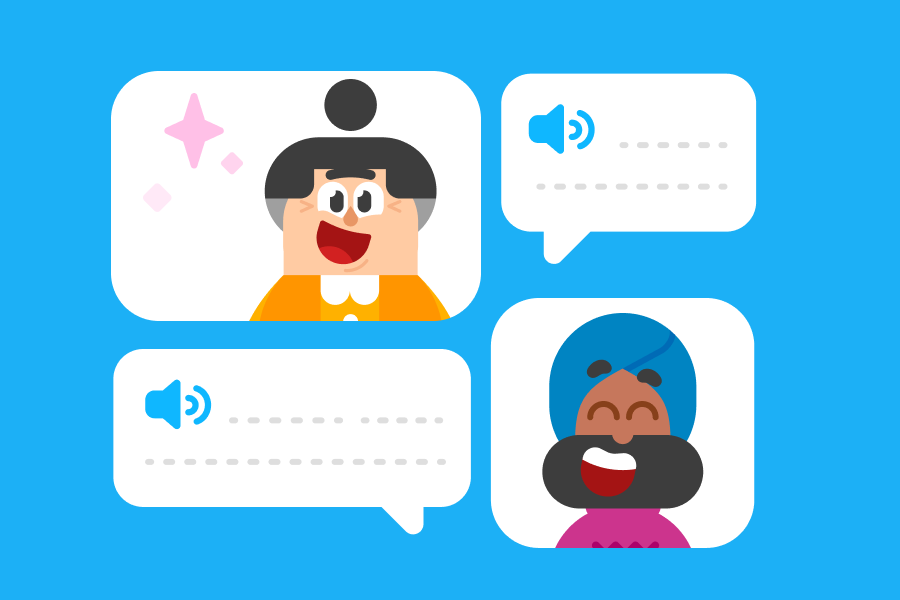Learning on Duolingo is fun and effective, but it might be unlike other courses you've taken! Our teaching method builds on the latest learning science research to be sure you can use the information you're learning, no matter what your goals are. One of the ways we do this is by leveraging implicit learning—a process that helps learners put new information into practice, right from the start.
What is implicit learning?
Implicit learning describes learning that happens through experience, interaction, and practice. Instead of focusing on memorization and the rules themselves, implicit learning is the result of using the rules to solve problems, learn from mistakes, and develop instincts for the new patterns or information.
Implicit learning can be contrasted with explicit learning: learning that happens through direct instruction that tells the learner the rules, how something works, or what the pattern is.
The difference between implicit and explicit learning isn't that one is good and the other bad. Which kind of learning is best for the task at hand depends on what you want to do with the information! And sometimes, one kind of learning is better suited to particular kinds of information.
It's also important to recognize that knowing about something isn't the same as being able to use it in practice, in the situations when you need it. People learning new information as adults often like to know the rules behind the patterns learning—it makes us feel in control!—but to actually do the new skill, relying too heavily on the explicit information can get in the way. (Imagine if you recited to yourself the rule for Spanish verb conjugations every time you had to use a verb in conversation!)
Examples of implicit and explicit learning
Whether you’ve heard of these terms or not, you've definitely done both kinds of learning!
🌍 Capital cities
If you want to learn the capital city of every country in the world, you might explicitly memorize them—by creating flashcards, studying a map, or making a song to help remember them.
But some of the capitals you might already know implicitly, from having learned them through experience—maybe you once read a book that took place in Paris (capital of France), backpacked through South America years ago and know Lima (capital of Peru) and Santiago (capital of Chile), or had a friend who moved to Manila (capital of the Philippines).
🎵 Greatest hits of 2003
You could google "top 50 songs of 2003" and then explicitly learn them by memorizing them, studying the trends in pop music in the early 2000s, or learning one a day for 50 days.
However, there are many among us who acquired knowledge of the 2003 chart-toppers implicitly, from hearing "Seven Nation Army" on the radio 100 times an hour back in '03, stealing their older sister's copy of Dangerously in Love, and remembering exactly where they were when they heard "In da Club" for the very first time.
🤹 Secret talents
If you wanted to impress your peers with a juggling act, you could read about the physics of juggling, read step-by-step instructions, and otherwise try to learn explicitly… but to actually juggle it would probably be best to start learning implicitly as soon as possible!
If you want to use your new juggling skill, knowing about juggling won't be as useful to you as being able to get a few objects into the air (even if they're not there for long!).
Implicit learning on Duolingo
Duolingo courses leverage implicit learning because we want our learners to be able to use the information they're studying. After all, if you're studying a language, you probably want to speak it or enjoy music or movies in the language. And you're probably not studying math to impress friends and colleagues at parties—you probably want to put it into practice out in the world!
That's why in our courses, learners interact with information right from the start, in their very first lesson. This hands-on experience recognizing the information—words, decimals, anything!—and having to produce it, too, gets learners to pay close attention, look for patterns, test out hypotheses, and start using the language. We also create exercises that visually draw learners' attention to the most relevant information, to help you notice and remember it. This approach also means learners make mistakes… and that's ok! Mistakes are part of the learning process: They are your brain testing the possible rules, and making a mistake heightens your attention to all the parts of the pattern so you can improve your hypothesis for next time.
But there's a place for explicit instruction, too. Implicit and explicit learning can work together effectively for many topics, especially if it's difficult to get enough exposure to or interaction with some kinds of information. Explicitly learning a rule or pattern can help move your learning along by directing you to the correct hypothesis—but remember that knowing the information won't be a replacement for learning to use it. That's why Duolingo courses give you extra, explicit information in section overviews, unit guidebooks, and right here on the blog—but putting it to use should be a priority!
Learn the way your brain learns best
For developing new skills you can really use, implicit learning can't be beat. That's why Duolingo prioritizes interacting with new information right from the start. We want to get you using your new skill from the very first lesson!



